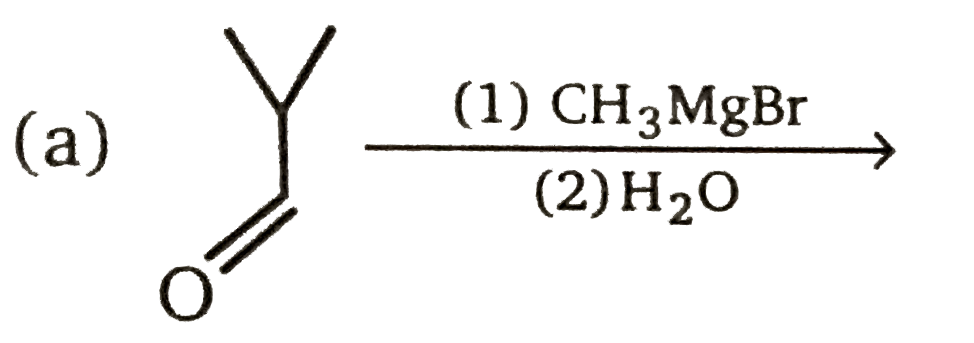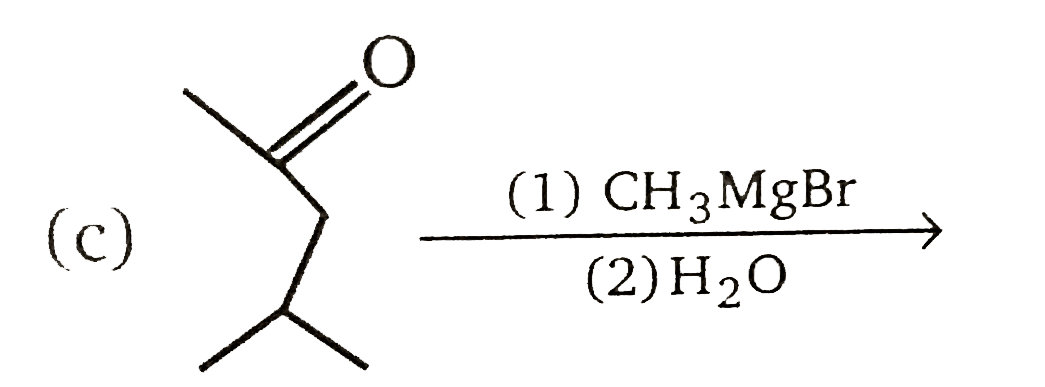In which of the following reactions 3∘ alcohol will be obtained as a product.

PhMgBr (excess) +CH3−O∣∣C−CH3→−−→H+
CH3MgBr(excess)+CH3−O∣∣C−O−O∣∣C−CH3→−−→H+
CH3MgBr(excess)+Cl−O∣∣C−O−Et→−−→H+
To determine which reactions yield a tertiary alcohol, we will analyze each option step by step.
Step 1: Analyze the First Reaction
- Reactants: Cyclopropyl magnesium bromide (Grignard reagent) and chloroform (CHCl₃).
- Mechanism: The Grignard reagent acts as a nucleophile and attacks the electrophilic carbon in chloroform, forming a Grignard adduct. The adduct then reacts with H⁺ to form an alcohol.
- Product: The product is a secondary alcohol because the carbon atom bonded to the hydroxyl (–OH) group is attached to two other carbon atoms (from cyclopropyl).
- Conclusion: This reaction does not yield a tertiary alcohol.
Step 2: Analyze the Second Reaction
- Reactants: Phenyl magnesium bromide (Grignard reagent) and acetone (CH₃COCH₃).
- Mechanism: The nucleophilic carbon from phenyl magnesium bromide attacks the electrophilic carbon in acetone, forming a Grignard adduct. This adduct then reacts with H⁺ to yield an alcohol.
- Product: The resulting alcohol has the hydroxyl group attached to a carbon that is bonded to three other carbon atoms (two from the methyl groups and one from the phenyl group).
- Conclusion: This reaction yields a tertiary alcohol.
Step 3: Analyze the Third Reaction
- Reactants: Methyl magnesium bromide (Grignard reagent) and acetic anhydride (CH₃CO)₂O.
- Mechanism: The nucleophilic carbon from methyl magnesium bromide attacks the electrophilic carbon in acetic anhydride, forming a Grignard adduct. The adduct then reacts with H⁺ to form an alcohol.
- Product: The resulting alcohol has the hydroxyl group attached to a carbon that is bonded to three other carbon atoms (two from the methyl groups and one from the original acetic anhydride).
- Conclusion: This reaction also yields a tertiary alcohol.
Step 4: Analyze the Fourth Reaction
- Reactants: Methyl magnesium bromide (Grignard reagent) and a chloroester.
- Mechanism: The nucleophilic carbon from methyl magnesium bromide attacks the electrophilic carbon in the chloroester, forming a Grignard adduct. The adduct then reacts with H⁺ to yield an alcohol.
- Product: The resulting alcohol has the hydroxyl group attached to a carbon that is bonded to three other carbon atoms (two from the methyl groups and one from the original chloroester).
- Conclusion: This reaction yields a tertiary alcohol.
Final Conclusion
After analyzing all four reactions:
- Reactions yielding tertiary alcohol: 2, 3, and 4.
- Reaction yielding secondary alcohol: 1.
Thus, the correct answer is that 3-degree alcohol will be obtained as a product in reactions 2, 3, and 4.
- Reactants: Cyclopropyl magnesium bromide (Grignard reagent) and chloroform (CHCl₃).
- Mechanism: The Grignard reagent acts as a nucleophile and attacks the electrophilic carbon in chloroform, forming a Grignard adduct. The adduct then reacts with H⁺ to form an alcohol.
- Product: The product is a secondary alcohol because the carbon atom bonded to the hydroxyl (–OH) group is attached to two other carbon atoms (from cyclopropyl).
- Conclusion: This reaction does not yield a tertiary alcohol.
- Reactants: Phenyl magnesium bromide (Grignard reagent) and acetone (CH₃COCH₃).
- Mechanism: The nucleophilic carbon from phenyl magnesium bromide attacks the electrophilic carbon in acetone, forming a Grignard adduct. This adduct then reacts with H⁺ to yield an alcohol.
- Product: The resulting alcohol has the hydroxyl group attached to a carbon that is bonded to three other carbon atoms (two from the methyl groups and one from the phenyl group).
- Conclusion: This reaction yields a tertiary alcohol.
- Reactants: Methyl magnesium bromide (Grignard reagent) and acetic anhydride (CH₃CO)₂O.
- Mechanism: The nucleophilic carbon from methyl magnesium bromide attacks the electrophilic carbon in acetic anhydride, forming a Grignard adduct. The adduct then reacts with H⁺ to form an alcohol.
- Product: The resulting alcohol has the hydroxyl group attached to a carbon that is bonded to three other carbon atoms (two from the methyl groups and one from the original acetic anhydride).
- Conclusion: This reaction also yields a tertiary alcohol.
- Reactants: Methyl magnesium bromide (Grignard reagent) and a chloroester.
- Mechanism: The nucleophilic carbon from methyl magnesium bromide attacks the electrophilic carbon in the chloroester, forming a Grignard adduct. The adduct then reacts with H⁺ to yield an alcohol.
- Product: The resulting alcohol has the hydroxyl group attached to a carbon that is bonded to three other carbon atoms (two from the methyl groups and one from the original chloroester).
- Conclusion: This reaction yields a tertiary alcohol.
After analyzing all four reactions:
- Reactions yielding tertiary alcohol: 2, 3, and 4.
- Reaction yielding secondary alcohol: 1.
Topper's Solved these Questions
Similar Questions
Knowledge Check
In which of the following reaction 3∘ alcohol will be obtained as a product ?
AMgBr(excess)+H−O∣∣C−Cl→−−→H+BPhMgBr(excess)+CH3−O∣∣C−Cl→−−→H+CCH3MgBr(excess)+CH3−O∣∣C−O−O∣∣C−CH3→−−→H+DCH3MgBr(excess)+CL−O∣∣C−O−Et→−−→H+In which of the following reactions, tertiary alcohol will be obtained as a product ?
A B
B C
C D
D
In which of the following reaction 2∘ alcohol is obtained as a product ?
A B
B C
C DBoth (a) and (b)
DBoth (a) and (b)
In which of the following reaction 1,3-butadiene will be obtained as a major product?
View SolutionIn which of the following reaction cyanide will be obtained as a major product?
View SolutionIn which of the following reaction cyanide will be obtained as a major product ?
View SolutionIn which of the following reaction, phosphine is not obtained as product
View SolutionIn which of the following reactions, alcohol is formed as product gives positive iodoform test?
View Solution
